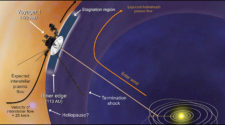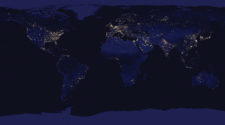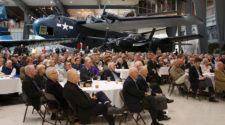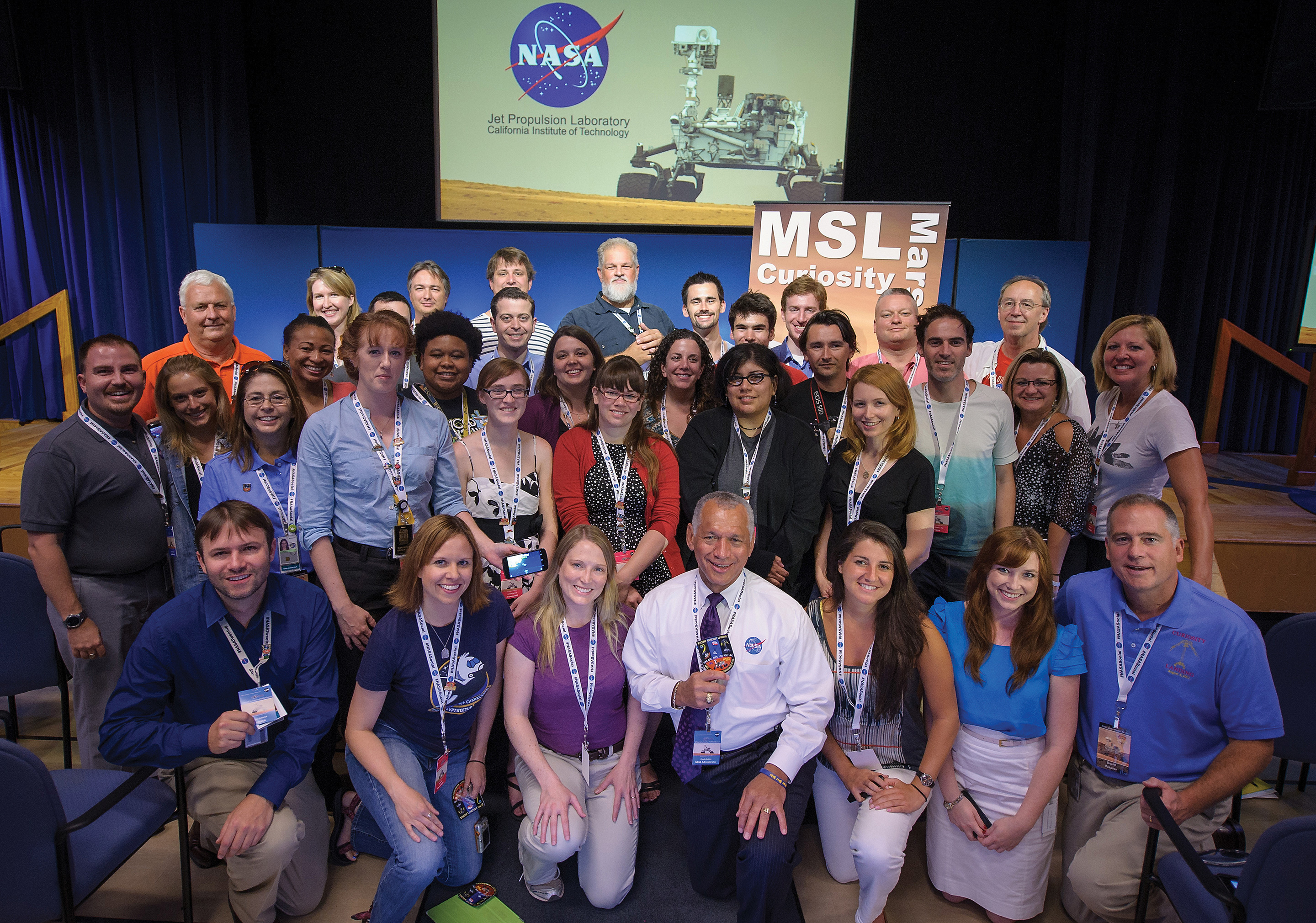
The city of Los Angeles is no stranger to celebrity sightings. But for a few days last summer, well-heeled movie stars traded places with some of NASA’s best and brightest scientists and engineers.
In what was described by John Holdren, President Obama’s senior science advisor, as “the most challenging mission ever attempted in the history of robotic planetary exploration,” NASA’s Jet Propulsion Laboratory (JPL) landed an SUV-sized rover named Curiosity on the surface of Mars, following a diabolically complex and breathtaking feat of engineering. After nearly 10 years and $ 2.5 billion worth of effort, the rover, humanity’s best hope so far for finding microbial alien life on the Red Planet, dazzled the world with a picture-perfect landing.
Curiosity is the latest in a series of progressively advanced rovers to visit the fourth planet from our sun. Before Curiosity, the popular twin rovers Spirit and Opportunity left their marks in the scarlet soil. Designed to operate for only 90 days, the rovers wildly exceeded everyone’s expectations. Opportunity, still exploring, has been roving for nearly nine years.
JPL hit upon a simple yet clever way to make people care about the science coming out of the prestigious Pasadena campus: they gave the robotic emissaries their own online voice, imbuing them with a personification usually reserved for the likes of Disney cartoon animals. It worked. The public was hooked. When Curiosity joined its hearty brethren, it too was already well on its way to becoming a national social media obsession. Moments after touchdown, Curiosity, via its Twitter account (@MarsCuriosity), announced, “I’m safely on the surface of Mars. GALE CRATER I AM IN YOU!!!”
NASA recently announced plans for the launch of another robotic science rover in 2020.
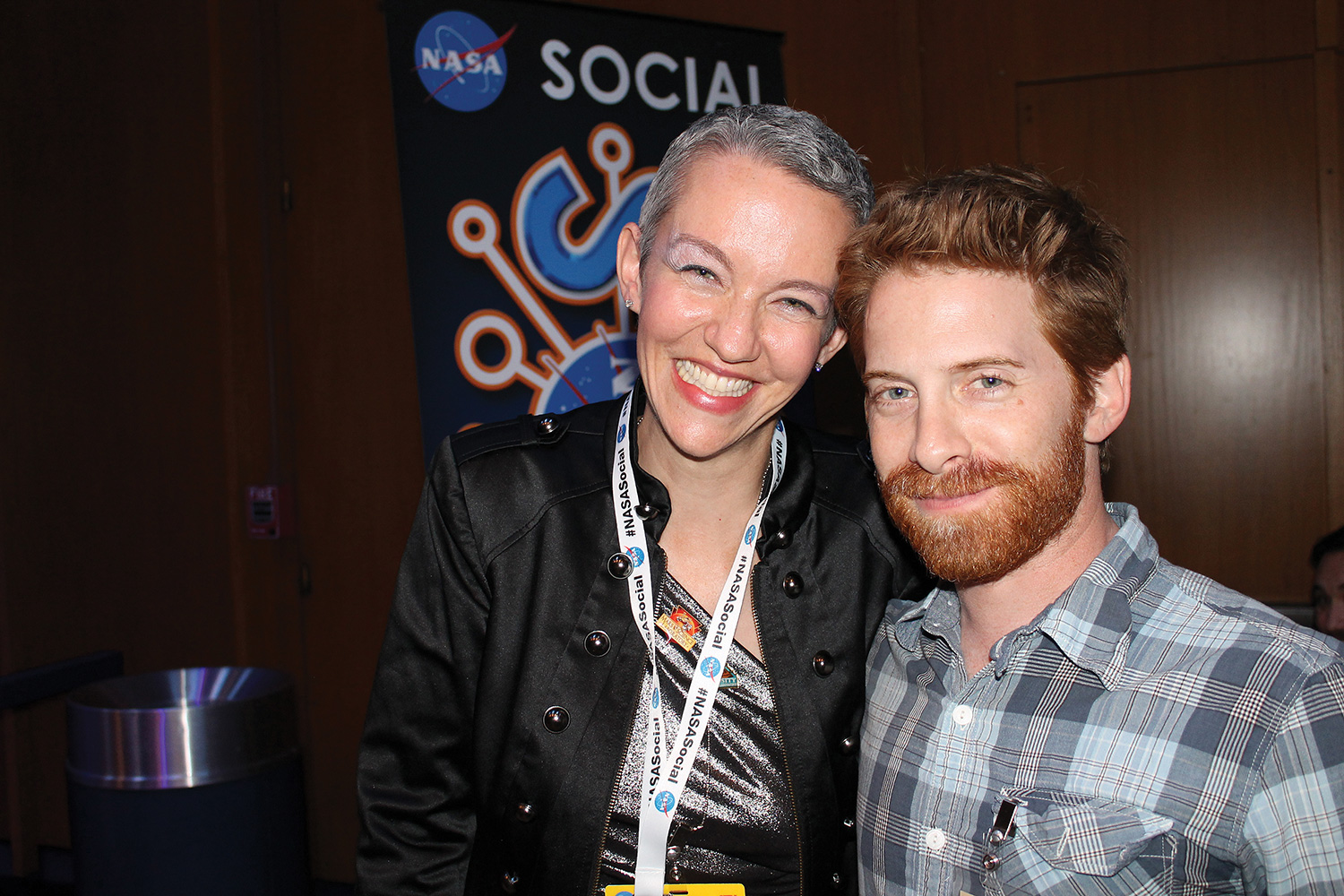
Curiosity’s first-person voice is supplied by a small but enthusiastic team of NASA/JPL communication professionals led by Veronica McGregor (@VeronicaMcG) who, back in 2008, already was channeling the Mars Phoenix lander. With nearly 1.2 million Curiosity followers (and more than 465,000 Facebook fans), it is obvious that McGregor and her social media team: Stephanie Smith (@Stephist) and Courtney O’Connor (@CourtOConnor) are on to something big. But they didn’t stop there. Dedicated to getting the word out to as many people as possible, McGregor held NASA’s first ever Social in 2009, an event that allowed guests a once-in-a-lifetime experience, exclusive access to scientists, engineers and astronauts, as well as the NASA facilities at which they work.
“Our first social was a three-hour event,” McGregor said. “I wanted the time to be convenient for people driving in from all parts of Los Angeles. What I didn’t expect was that we would get people flying in from all across the country! That was the first hint that these socials were going to be a hit. There were several people who questioned the value of holding that first event. I think I saw a few snickers behind my back. But within six months, socials were being held at NASA Headquarters and other NASA field centers. By the end of the year, they were being held at Kennedy Space Center for space shuttle launches. Safe to say no one questions the value of socials anymore!”
NASA Socials let space enthusiasts meet and spread information to those who can’t be there in person. We all nerd out on how cool humans can be.
— Seth Green
NASA’s budget may be a paltry half a penny on the tax dollar, but you’d never know it based on their vibrant online presence. Arguably the most loved and lauded government agency, NASA enjoys a social media footprint second only to the White House, and has won numerous government and internet awards for its efforts to engage the public.
“Our attendees are citizen journalists who communicate to their audiences with their tweets, posts, photos and videos,” McGregor said. “Millions of potential impressions are generated with each event.”

One of those attendees was John Zeller (@JohnLukeZeller), founder of the website #Penny4NASA. Zeller was one of 2,300 people who applied for the Mars Curiosity social. Only 26 got in.
“These socials are so important because they’re getting the word out to people who aren’t already tuned in,” Zeller said. “The most important thing is getting people educated — this stuff sells itself once they are exposed to it.”
Susan Bell (@susanbellfilm), a film and television producer who dreamed of becoming an astronaut as a child was inspired to get her pilot’s license after a visit to a NASA field center. “NASA isn’t in the news enough. People need to know what’s going on. In this day and age, with all the funding issues, the more people who know the amazing things NASA is doing, the better. We need to spread the word about how much value there is in what NASA does.” Susan said.
While at JPL, NASA Social participants were treated to a slew of high-ranking NASA officials, including NASA Administer Charles Bolden, Deputy Administrator Lori Garver (@Lori_Garver), JPL Director Charles Elachi, astronaut John Grunsfeld (@SciAstro), and a handful of senior engineers responsible for getting Curiosity safely to its new home, including Mars Science Laboratory Mechanical Systems Lead Adam Steltzner (@Steltzner). They also attended NASA briefings and asked questions, alongside members of the national and international press.
“I never dreamed I’d be at the sort of NASA press conferences I’ve watched on TV all my life,” said Brad Snowder (@skywise88), an astronomy professor and amateur telescope maker. “Talk about geek juice — it’s like I’ve been mainlining this week. It’s geek heaven.”
That’s exactly the sort of reaction NASA is hoping for.

“So much of what we do in communications is a one-way transmission of message,” said Michael Cabbage, director of news and multimedia at NASA Headquarters in Washington, DC.“ But with social media it’s two-way — transmitting and receiving. There’s a dialogue. That’s the way of the future.”
NASA Social Media Manager John Yembrick (@Yembrick), agrees. “NASA has a unique story that resonates with a lot of people from around the world. Whether we participate or not, folks on social media are going to discuss NASA, our missions, and our brand. Social media allows us to be part of that conversation. Through our social media efforts, we’re seeing a whole new level of interest in science, technology, engineering and math, which we hope will inspire the next generation of explorers.”
The three-day event wasn’t all lectures and press conferences. The attendees also took in a theatrical presentation of the popular viral hit, “Seven Minutes of Terror”. They also were given a demonstration of “Eyes on the Solar System.” A 3-D environment populated with real NASA mission data by popular creator Doug Ellison (@Doug_Ellison), and toured JPL’s Mission Control and the popular Mars Yard, where test rovers traverse simulated Martian rock fields. Before NASA Socials, this sort of access was reserved for VIPs and visiting dignitaries.

“Seeing the looks on the faces of people as they did the tour made my day,” McGregor said. “The attendees seemed flattered that mission personnel would talk to them and take their questions, but on the other hand our teams love to tell their story.”
While NASA Socials are populated by citizens from all walks of life, they frequently draw more recognized faces as well. Actor Seth Green (@SethGreen), who attended a NASA Social for the final launch of the space shuttle, considers himself a lifelong fan of the agency.
“The Internet has made it possible for people all over the world to share these world-changing events,” Green said. “NASA Socials let space enthusiasts meet and spread information to those who can’t be there in person. We all nerd out on how cool humans can be.”
Green isn’t the only movie star smitten by NASA’s work in the final frontier. NASA Social attendees also were able to rub elbows with surprise celebrity guests like Star Trek’s Nichelle Nichols and Wil Wheaton (@wilw), The Big Bang Theory creator, Bill Prady (@BillPrady), Black Eyed Peas’ frontman will.i.am (@iamwill), and Jeopardy’s Alex Trebek.
It was the most exciting, heart-wrenching, deliriously joyful event I have ever experienced.
— Abraham Benrubi
NASA Socials draw like-minded participants from all corners of the globe, creating deep and lasting bonds among participants, who frequently end up rooming together and spending every free minute in each other’s company. They commonly create online communities to stay in touch and launch their own reunion events to relive the moments they shared, and strategize how better to advocate for their mutual passion.
“Once space fans find each other, they tend to stick together,” an understandably satisfied McGregor said.
In the minutes leading up to Curiosity’s landing, the tension in the auditorium housing the social attendees and expectant members of the press could be carved with a knife. With each success of Curiosity’s chain of impossibly difficult descent procedures, the social attendees erupted in euphoric applause. When the call went out that Curiosity was safely on the surface, that euphoria manifested itself as an exuberant demonstration of affection and tears of elation.

“It was the most exciting, heart-wrenching, deliriously joyful event I have ever experienced,” said actor Abraham Benrubi (@AbrahamBenrubi).“ It was an historic achievement for mankind. To have been able to soak up that level of joy is a once in a lifetime moment.”
NASA knows Benrubi’s feelings mirror that of his fellow participants. And the agency knows with each social it holds, NASA gains supporters exponentially. Unlike any other facet of the government, NASA’s mission inspires the hopes and dreams of a country beset by financial doldrums and social turmoil. NASA’s explorers, whether human or robotic, represent the very best of American ideals and potential.
While NASA has announced only two socials for 2013 thus far — the launch of the TDRS-K satellite from Cape Kennedy in Florida, and the launch of the Landsat Data Continuity Mission (LDCM) from Vandenberg AFB in California — more are in the works, including socials with astronauts, scientists, engineers, and, of course, other launches, including one at a NASA center which has never hosted such an event before.
“NASA Socials create lifelong ambassadors of the space program,” Yembrick said. “It’s the gift that keeps on giving.”

Brandon Fibbs contributed to this article.

